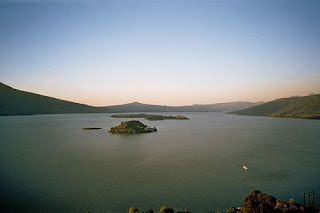Patzcuaro, Uruapan and St. Clara de Cobre.
For a weekend excursion by car from Mexico City, follow the toll road west from
La Capital towards to Toluca and Morelia to the towns of Uruapan, Patzcuaro and the magical artisan community St. Clara de Cobre.
Lago de Patzcuaro is a volcanic lake and home to the early indigenous tribe that worked copper, said to be the only copper artisans in Central America.
They used copper for their hatchets and other weapons as well as to make containers.
Recommended buildings for visitors to visit in Patzcuaro include Casa de los Once Patios (House of the Eleven Patios), Biblioteca Gertrudis Bocanegra with the celebrated murals bv Juan O'Gorman and the Basilica.
The market area includes House of Eleven patios offers souvenir goods, however a few shops tucked away off the main walking route, do sell authentic hand-woven cotton cloth, copper containers and decorative creations, placemats, and inlaid wooden items.
Survey the entire shopping area before buying, not to search for better prices, but unusual items or better quality work and design.
Tzintzuntzan is the meso-American archeological site above the town, the area of the Chichimecas tribes. Bring along a guidebook for historical perspective. In the town of Tzintzuntzan, the Franciscan Monastery grounds were planted by the Spanish monks with olive trees that are still growing there fine hundred and ten years later.
In Uruapan, to the northwest of Park Eduard Ruiz which lies in a deep ravine, there’s a liquor store (address: 87C Pino Suares) an outlet for the liquor factory, located outside of town. They sell sugar cane liquor (aka rum or charanda), in various flavors. Charanda Dorada el Terasco is a favorite.
I bought coffee flavored liquor, remembering my student days in Toronto, when we would make the delicious potion at home with raw alcohol (Ever-Clear) and thick coffee syrup made with excessive doses of powdered espresso coffee concentrate. You were supposed to let it cure for a few weeks, but I always seemed to crack open the bottle early. Four months after buying this Mexican coffee liquor, it is still sealed.
In the copper shops in the village of Santa Clara de Cobre, you can watch artisans at work. The fierce banging of mallets and shaping tools on the dense copper shapes could be a drawback for visitors, so bring ear plugs if noise bothers you. This town is famous for the traditional artisans who work in copper. The nearby Copper Museum displays metal working tools set up and ready for use.
Ask to see the obsidian ornaments. Copper bells and smaller objects are for sale. The bells look a little like castanets and are similar to bells attached to grazing animals. Oval in shape, with clapper covered by two oval sides.
Where to Stay: In Patzcuaro, the Hotel Posada Don Vasco, Best Western Hotel with pool, restaurant and attractive grounds. Single room rates vary depending on the peso-dollar exchange rate. Rooms numbers 501 to 507 have balconies overlooking gardens.



